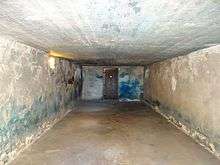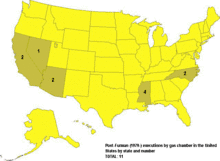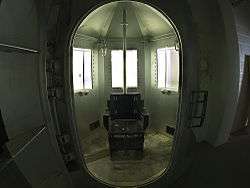Gas chamber
A gas chamber is an apparatus for killing humans or other animals with gas, consisting of a sealed chamber into which a poisonous or asphyxiant gas is introduced. Poisonous agents used include hydrogen cyanide, carbon dioxide and carbon monoxide.

History
General Rochambeau developed a rudimentary method in 1803, during the Haitian Revolution, filling ships' cargo holds with sulfur dioxide to suffocate prisoners of war.[1][2]
Gas chambers have been used as a method of execution for condemned prisoners in the United States beginning in the 1920s and continue to be a legal execution method in three states, seeing a possible reintroduction with nitrogen although redundant in practice since the 1990s.[3]
During the Holocaust, large-scale gas chambers designed for mass killing were used by Nazi Germany as part of their genocide program.
Lithuania used gas chambers during the 1930s.
United States


Gas chambers have been used for capital punishment in the United States to execute death row inmates. The first person to be executed in the United States by lethal gas was Gee Jon, on February 8, 1924. An unsuccessful attempt to pump poison gas directly into his cell at Nevada State Prison led to the development of the first makeshift gas chamber to carry out Gee's death sentence.[4]
On December 3, 1948, Miran Thompson and Sam Shockley were executed in the gas chamber at San Quentin State Prison for their role in the Battle of Alcatraz.
In 1957, Burton Abbott was executed as the governor of California, Goodwin J. Knight, was on the telephone to stay the execution.[5]
Since the restoration of the death penalty in the United States in 1976, eleven executions by gas chamber have been conducted. Four were conducted in Mississippi, two in Arizona, two in California, two in North Carolina and one in Nevada.[6] By the 1980s, reports of suffering during gas chamber executions had led to controversy over the use of this method.
At the September 2, 1983, execution of Jimmy Lee Gray in Mississippi, officials cleared the viewing room after eight minutes while Gray was still alive and gasping for air. The decision to clear the room while he was still alive was criticized by his attorney. David Bruck, an attorney specializing in death penalty cases, said, "Jimmy Lee Gray died banging his head against a steel pole in the gas chamber while reporters counted his moans."[7] Gray was convicted for the murder of three-year-old Deressa Jean Scales in 1976, after kidnapping and anally raping her.[8]
During the April 6, 1992, execution of Donald Harding in Arizona, it took 11 minutes for death to occur. The prison warden stated that he would quit if required to conduct another gas chamber execution.[9] Following Harding's execution, Arizona voted that all persons condemned after November 1992 would be executed by lethal injection.[6]
Following the execution of Robert Alton Harris, a federal court declared that "execution by lethal gas under the California protocol is unconstitutionally cruel and unusual."[10] By the late 20th century, most states had switched to methods considered to be more humane, such as lethal injection. California's gas chamber at San Quentin State Prison was converted to an execution chamber for lethal injection.
As of 2020, the last person to be executed in the gas chamber was German national Walter LaGrand, sentenced to death before 1992, who was executed in Arizona on March 3, 1999. The U.S. Court of Appeals for the Ninth Circuit had ruled that he could not be executed by gas chamber, but the decision was overturned by the United States Supreme Court.[6] The gas chamber was formerly used in Colorado, Nevada, New Mexico, North Carolina and Oregon. Six states, Arizona, California, Maryland, Mississippi, Missouri and Wyoming, authorize lethal gas if lethal injection cannot be administered, the condemned committed their crime before a certain date, or the condemned chooses to die in the gas chamber.[11] In October 2010, Governor of New York David Paterson signed a bill rendering gas chambers illegal for use by humane societies and other animal shelters.[12]
Soviet Union
According to Zhirnov, in Soviet Union, NKVD commander Isay Berg adapted vans with the storage compartment sealed and exhaust redirected inside it. These vans were used by NKVD during the Great Purge under disguise of bread vans to poison the victims during their transportation to the execution.[13][14]
Lithuania
In 1937–1940, Lithuania operated a gas chamber in Aleksotas within the First Fort of the Kaunas Fortress.[15] Before, the executions were carried out by hanging or by shooting. However, these methods were viewed as brutal and in January 1937, the criminal code was amended to provide execution by gas which at the time was viewed as more civilized and humane. Lithuania considered and rejected execution by poison. The first execution was carried on July 27, 1937: Bronius Pogužinskas, age 37, convicted of murder of five people from a Jewish family.[15] Historian Sigita Černevičiūtė counted at least nine executions in the gas chamber, though records are incomplete and fragmentary. Of the nine, eight were convicted of murder. One, Aleksandras Maurušaitis, was in addition convicted of anti-government actions during the 1935 Suvalkija strike. The last known execution took place on May 19, 1940 for robbery. The fate of the gas chamber after the occupation by the Soviet Union in June 1940 is unclear.[15]
Nazi Germany
Nazi Germany made extensive use of various types of gas chamber for mass killing.
Beginning in 1939, gas chambers were used as part of the Nazi euthanasia program aimed at eliminating physically and intellectually disabled people. Experiments in the gassing of patients were conducted in October 1939 in occupied Posen in Poland. Hundreds of prisoners were killed by carbon monoxide poisoning in an improvised gas chamber.[16] In 1940 gas chambers using bottled pure carbon monoxide were established at six euthanasia centres in Germany.[17] In addition to persons with disabilities, these centres were also used to kill prisoners transferred from concentration camps in Germany, Austria, and Poland. Killings of concentration camp inmates continued after the euthanasia program was officially shut down in 1941.[18]
During the invasion of Russia, mass executions by exhaust gas were performed by Einsatzgruppen using gas vans, trucks modified to divert engine exhaust into a sealed interior gas chamber.[17]
Starting in 1941, gas chambers were used at extermination camps in Poland for the mass killing of Jews, Roma, and other victims of the Holocaust. Gas vans were used at the Chełmno extermination camp. The Operation Reinhard extermination camps at Bełżec, Sobibór, and Treblinka used exhaust fumes from stationary diesel engines.[17] In search of more efficient killing methods, the Nazis experimented with using the hydrogen cyanide-based fumigant Zyklon B at the Auschwitz concentration camp. This method was adopted for mass killings at the Auschwitz and Majdanek camps. Up to 6000 victims were gassed with Zyklon-B each day at Auschwitz.[17]
Most extermination camp gas chambers were dismantled or destroyed in the last months of World War II as Soviet troops approached, except for those at Dachau, Sachsenhausen and Majdanek. One destroyed gas chamber at Auschwitz was reconstructed after the war to stand as a memorial.
North Korea
Kwon Hyok, a former head of security at Camp 22, described laboratories equipped with gas chambers for suffocation gas experiments, in which three or four people, normally a family, are the experimental subjects.[19][20] After undergoing medical checks, the chambers are sealed and poison is injected through a tube, while scientists observe from above through glass. In a report reminiscent of an earlier account of a family of seven, Kwon claims to have watched one family of two parents, a son and a daughter die from suffocating gas, with the parents trying to save the children using mouth-to-mouth resuscitation for as long as they had the strength. Kwon's testimony was supported by documents from Camp 22 describing the transfer of prisoners designated for the experiments. The documents were identified as genuine by Kim Sang Hun, a London-based expert on Korea and human rights activist.[21] A press conference in Pyongyang, organized by North Korean authorities, denounced this.[22][23]
Method of use
Using hydrogen cyanide


As implemented in the United States, the gas chamber is considered to be the most dangerous, most complicated, and most expensive method of administering the death penalty.[24][25][26] The condemned person is strapped into a chair within an airtight chamber, which is then sealed. The executioner activates a mechanism which drops potassium cyanide (or sodium cyanide)[27][28] pellets into a bath of sulfuric acid beneath the chair; the ensuing chemical reaction generates lethal hydrogen cyanide gas.
The gas is visible to the condemned, who is advised to take several deep breaths to speed unconsciousness. Nonetheless, the condemned person often convulses and drools. There may also be urinating, defecating, and vomiting.[29][30]
Following the execution the chamber is purged with air, and any remnant gas is neutralized with anhydrous ammonia, after which the body can be removed (with great caution, as pockets of gas can be trapped in the victim's clothing).[31]
Excluding all oxygen
Nitrogen gas or oxygen-depleted air has been considered for human execution, as it can induce nitrogen asphyxiation. The victim detects little abnormal sensation as the oxygen level falls. This leads to asphyxiation (death from lack of oxygen) without the painful and traumatic feeling of suffocation, or the side effects of poisoning.
In April 2015, Oklahoma Governor Mary Fallin approved a bill allowing nitrogen asphyxiation as an execution method.[32] On March 14, 2018, Oklahoma Attorney General Mike Hunter and Corrections Director Joe M. Allbaugh announced a switch to nitrogen gas as the primary method of execution.[33]
After struggling for years to design a nitrogen execution protocol, the State of Oklahoma announced in February 2020 that it was abandoning the project after finding a reliable source of drugs to carry out the lethal injection executions.[34]
References
- Mobley, Christina. "A War Within the War". Haiti: An Island Luminous. Duke University. Retrieved 25 Apr 2020.
- Boot, Max (15 Jan 2013). Invisible Armies: An Epic History of Guerrilla Warfare from Ancient Times to the Present (hardcover 1st ed.). New York: W. W. Norton & Company. p. 99. ISBN 978-0-87140-424-4. Retrieved 25 Apr 2020.
- "Methods of Execution - Death Penalty Information Center". deathpenaltyinfo.org. Archived from the original on 2011-02-25.
- "Descriptions of Execution Methods: Gas Chamber". Death Penalty Information Center. 2010. Archived from the original on November 12, 2010. Retrieved November 3, 2010.
- "Race in the Death House". Time. March 25, 1957. Archived from the original on March 30, 2008. Retrieved 2007-11-14.
- "German executed in Arizona, legal challenge fails". CNN. March 4, 1999. Archived from the original on October 11, 2008.
- "Some examples of post-Furman botched executions". Death Penalty Information Center. May 24, 2007. Archived from the original on November 22, 2007.
- Killer Of 3-Year-Old Mississippi Girl Executed After Justices Reject Plea. The New York Times (1983-09-02). Retrieved on 2007-11-12.
- Weil, Elizabeth (February 11, 2007). "The needle and the damage done". The New York Times. Archived from the original on April 21, 2017..
- Fierro, Ruiz, Harris v. Gomez, 94-16775 (U.S. 9th Circuit 1996).
- "Methods of execution". Death Penalty Information Center. Archived from the original on 2008-07-03.
- "Agriculture and Markets Law § 374". Retrieved January 31, 2012.
- Жирнов, Евгений; Жирнов, Евгений (11 September 2009). "По пути следования к месту исполнения приговоров отравлялись газом". p. 56 – via Kommersant.
- "Человек в кожаном фартуке". novayagazeta.ru. Archived from the original on 2015-07-10.
- Černevičiūtė, Sigita (April 8, 2014). "Dujų kamera prieškario Lietuvoje 1937-1940 metais" (in Lithuanian). 15 min (republished from Naujasis Židinys-Aidai). Archived from the original on November 27, 2016. Retrieved 2016-11-26.
- Browning, Christopher (2005). The Origins of the Final Solution: The Evolution of Nazi Jewish Policy, September 1939 – March 1942. Arrow. ISBN 978-0-8032-5979-9.
- "Gassing Operations". Holocaust Encyclopedia. United States Holocaust Memorial Museum. Archived from the original on 3 December 2017. Retrieved 30 November 2017.
- Klee, Ernst (1983). Euthanasie im NS-Staat. Die Vernichtung lebensunwerten Lebens [Euthanasia in the NS State: The Destruction of Life Unworthy of Life] (in German). Frankfurt am Main: Fischer Taschenbuch Verlag. ISBN 978-3-596-24326-6.
- Barnett, Antony (31 January 2004). "Revealed: the gas chamber horror of North Korea's gulag" – via The Guardian.
- Video testimonials by former guards and prisoners at Camp 22 Archived 2007-10-24 at the Wayback Machine, where the experiments are said to have occurred, with Google Earth images Camp 22 and other camps
- Olenka Frenkiel (January 30, 2004). "Within prison walls". BBC News. Archived from the original on June 23, 2009. Retrieved 2009-12-15.
- "DPRK civilians admit faking papers on chemical weapons testing on humans". Archived from the original on 4 March 2016. Retrieved 15 August 2016.
- Truth behind False Report about "Experiment of Chem. Weapons on Human Bodies" in DPRK Disclosed Archived 2005-10-28 at the Wayback Machine (North Korean Central News Agency)
- Handbook of Death and Dying by Clifton D. Bryant - Page 499
- "Archived copy". Archived from the original on 2015-07-10. Retrieved 2015-07-09.CS1 maint: archived copy as title (link) fourth paragraph
- "The History Channel" - Modern Marvels (gas chamber) Archived 2015-07-09 at the Wayback Machine
- "Archived copy". Archived from the original on 2015-06-28. Retrieved 2015-07-03.CS1 maint: archived copy as title (link) second paragraph
- "Execution by gas in Md. to end next week Killer Hunt's death will be last by method". The Baltimore Sun. Archived from the original on 2015-07-05.
- Encyclopedia of Capital Punishment in the United States, 2d ed. by Louis J. Palmer, Jr. (page 319)
- The Death Penalty As Cruel Treatment And Torture by William Schabas (page 194)
- "Descriptions of Execution Methods". Death Penalty Information Center. Archived from the original on 2 February 2015. Retrieved 2 February 2015.
- "Oklahoma Gov. Mary Fallin signs bill allowing nitrogen asphyxiation as alternative execution method". NewsOK.com. Archived from the original on 2016-03-29.
- Mark Berman (March 18, 2018). "Oklahoma says it will begin using nitrogen for all executions in an unprecedented move". Washington Post.
- "Oklahoma Attorney general says state will resume executions". New York Post. Retrieved March 22, 2020.
External links
| Wikiquote has quotations related to: Gas chamber |